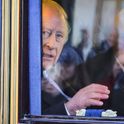The St Louis Hospital in the 10th arrondissement of Paris was founded in 1607, just outside the walls of Paris, to house an overflow of plague patients. Parts of the campus have the mansard rooves and stone courtyards of the 17th century and are used as administrative offices. On the evening of 13th November, Olivier Cauvet, a nurse in the intensive care unit, was having dinner after his shift with a group of friends from the hospital in a street nearby. The cross roads where 19 people were killed at Le Carillon and Le Petit Cambodge abuts one wall of the hospital grounds. The medical staff eat at them so often they're practically an extension of the hospital canteen. Olivier was at a restaurant only a few streets away. He didn't hear the shots. But then he saw people running away and then very quickly afterwards, ambulances, one and then another and then another.
Very quickly a colleague called to warn him there were reports of gunmen driving around the area, shooting randomly into restaurants. "Stay where you are!" his colleague told him. "Don't try and leave!" Olivier alerted the restaurant, they pulled the shutters down, several customers didn't want to be locked in and made their way out, despite the danger. After a short while his colleagues told him that wounded were arriving in the hospital and Olivier thought, "there's work to be done" and left the restaurant with a couple of his medical colleagues to get back and help. The hospital had shut its gates, they had to climb over the wall to get in.
The injured from Le Peitit Cambodge and the Carillon arrived all at the same time, about two dozen of them, in taxis and ambulances; several were carried in by friends. Almost all of them were seriously wounded. At the St Louis Hospital they see two or three gunshots a year, but almost always from small caliber handguns. They had never seen the damage that a Kalashnikov can cause. Olivier went immediately to the recovery room of the ICU unit where the wounded were being treated. The first thing he saw was a woman who had been shot in the face. He saw a nurse walk past totally white with shock and he caught up with her and gave her a bear hug, "I'm here, we're here," he told her. Then he went to gather materials, IV lines, bags of blood, bandages.
Dr Matthieu Legrand, professor of critical care medicine, was at home watching Orange is the New Black when his wife got a news alert on her iPhone from the newspaper Le Monde that there had been an explosion at the Stade de France. Two minutes later his chief of department called and said they were expecting gunshot victims, could he get into the hospital as fast as he could and take the lead for critical care? Dr Legrand jumped in his car and got to the hospital within five minutes, at about 9:45pm, just 20 minutes after the attacks on the restaurants. Patients and staff were arriving all at the same time, there was a few minutes of hectic chaos, triage, redirecting. He quickly assigned a doctor and two nurses to each patient: that's your patient: don't leave them!
He pointed to a man with a gunshot wound in his chest and told Olivier to take care of him. The bullet had gone through the soft tissue of his upper arm and into his torso underneath his armpit. Olivier saw that he was in his early 30s, the same age as his younger brother. "I'm in the X-Files, thought Olivier, "it's like science fiction." Then he went into procedural mode. He checked for responsiveness and consciousness and assessed it on the Glasgow Coma Scale (a neurological scale that assesses a patient's level of consciousness). The man was pale and trembling.
"Hello I'm Olivier," he said and smiled reassuringly. He squeezed the patient's hand.
"What happened?" asked the patient.
"I am a nurse, I am going to stay with you." Olivier didn't tell him everything was going to be OK, because he didn't know if it would be. Another nurse took over for a moment, he went to find a chest drain but there weren't any in the usual store so he had to go and find one in the reserve supply. The doctor ordered a CT scan and Olivier and the other nurse took him. The hospital has two scanners, only one would usually have been operational that night, the second was immediately opened up.
[gallery ids="39870,39871,39873,39874,39875,39876,39877,39879"]
Olivier was worried because the patient was bleeding a lot. His own tunic was covered in the blood and he tried to draw his white coat over it so that the patient wouldn't become distressed on seeing it. The patient's blood pressure was low and he was tachycardic. His breathing was OK; Olivier had given him oxygen in a tube underneath his nostrils; it seemed to be enough, but he put an oxygen mask in his pocket just in case. When they lifted him up to place him on the CT scanner bed, Olivier could see that he was in pain. He looked over at the attending doctor,
"Morphine?" The doctor nodded and Olivier administered a shot of the pain killer. Inside the scanner the patient was all alone. Olivier waved to him through the operators window, thumbs up, I'll be back!
"Just like Schwarzenegger!" Olivier laughed in the retelling.
Olivier is jolly and empathetic, Dr Legrand as heartthrob as a French doctor rescuing the lead actress in a romantic comedy. They sat around a table at the hospital a little less than a week later, describing that night to me with Dr Axelle Ferry, who had been on duty in charge of the hospital's burns unit that night. Dr Ferry was young and chic and serious. When she understood there were no burns victims on the way, she had gone to the recovery room to help.
The first thing that she saw was the woman with the terrible facial wound. There was a moment of disbelief, she said. She took a step back, before she recovered herself. Dr Legrand said to Dr Ferry, "you OK?" She nodded. "Then this is your patient."
The patient had been shot five times. She was unconscious. Dr Ferry began to focus on the job at hand. She intubated with a tracheal tube; the patient's airway was partially obstructed with her wound. Dr Ferry didn't know the ICU ward and she was unsure where things were kept. But the team kicked in, as soon as she shouted for something, someone pointed or found it for her.
All three of them talked about the intensity of the situation. Time was suspended, irrelevant. They worked minute by minute. After the initial hubbub, a calm descended as they worked to triage, stabilize, send patients to be scanned and get them into operating theatres. One man had a bullet lodged very close to his heart. Another man had two bullets in his stomach and three in his limbs. They took him directly to the operating theatre. Dr Legrand was careful not to get distracted by any single patient so that he could retain an overview of the situation. The instinct was to send patients as soon as possible to the operating theatre, but he was conscious that the terrorists were still at large, the siege at the Bataclan theatre had not been concluded and they had no idea of how many more patients they might have to deal with. It was important to retain some capacity. Of the six operating theatres that were opened that night, he kept three empty in case there was a new influx. In the small hours they transferred patients with shattered bones to other hospitals with orthopedic surgeons.
It turned out that Olivier's patient's wounds were not as dangerous as he had first feared. The bullet had broken up into several pieces in his chest, one was only millimeters from his heart and the scan showed a few air bubbles in his chest from a partially damaged lung, but they decided not to operate. The patient stabilized, colour came back into his cheeks, he called his family and his friends from his mobile and told then he was in hospital and OK. He began to smile a little and talk to Olivier.
"You are all robots!" he told him and Olivier was a little abashed because he thought maybe he meant that they were behaving a bit unemotionally, but then he realised it was a compliment to their brisk efficiency.
After an hour or so the situation was in hand. Dr Ferry showed me a picture on her mobile phone taken that night in the recovery room. Dozens of doctors and interns and nurses, in green surgical scrubs or blue sterile tunics or white costs were standing, bent to their work, among a crowd of patients on trolleys. They received 27 patients that night. All of them survived.
"We are really proud we managed so well," Dr Legrand told me. Olivier joked, "because it's not always like this!"
"For me," continued Dr Legrand, "it was a chance to do my job well, to feel useful."
Olivier got a lift home with a colleague at about 6:30am. The minute he got home he felt guilty for leaving his patient and he immediately rang his colleague at the hospital who had taken over from him to check how he was. His colleague assured him he was fine. Then Olivier sat down and shook for ten minutes. Then he went to bed and fell asleep like a stone.
Dr Ferry didn't get home until the afternoon of the following day.
Dr Legrand went home at a little after 5 am. The patients had all been attended to, the recovery room was virtually cleared and everything had been reset so that they could deal with another crisis if it happened.
"Now I feel like I should have stayed a little longer," he told me, "I knew the patients were taken care of, but for my colleagues, to stay and have breakfast with them. But the truth is I wanted to hug my family." He has two children, six and three; his wife is pregnant with their third.
On Sunday he and his wife, who is a psychiatrist, prepared their six-year-old daughter for the minute's silence that would be held for the victims at school the next day. They found an internet site with drawings that were helpful to explain the terrorist attacks to children.
"Daddy can the bad guys get into the school?" his daughter asked him and he pointed to the information online and said, no they couldn't. The next day when his wife took her to school his daughter stopped for a moment at the threshold and asked again, "they can't get into the school can they?" and then reassured herself, referring to the information on line, "no it was written that they can't."
"She's OK" said Dr Legrand, "but I noticed over the past few days when I get home from work, she hugs me tighter than usual."
Inside the St Louis hospital: treating the victims of terror
The heroic doctors and nurses tell their story
November 23, 2015











